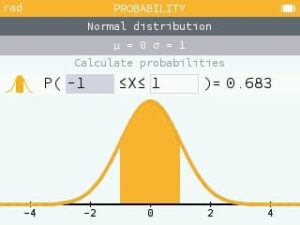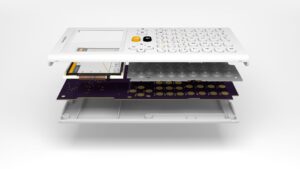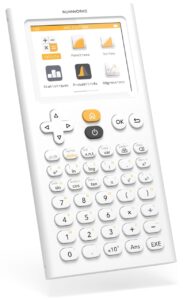NumWorks is a French company that is making great waves today by releasing the slimmest and first open graphing calculator for high school students in North America and Europe, thanks in part to an STM32F4 microcontroller (MCU). It’s impossible to overestimate a teacher’s impact on the appreciation students have for a subject. Unfortunately, not all children have access to the best classrooms, which is why NumWorks worked with educators to build a tool that can make learning math, engineering, and computer science fun and intuitive, and it all starts with their design.
In the era of sleek smartphones, the traditional graphing calculator looks like a relic from the Dark Ages. This is why the minimalist design and bright display of the calculator, also called NumWorks, hits home. On top of it, the firm has opened the hardware, the operating system, applications, and it even added a python interpreter (MicroPython). As a result, students will at least benefit from a modern device that will reduce the friction often associated with algebra or calculus, and at best, curious pupils will start to learn programming and engineering. They can even print some parts using a 3D printer, thanks to a very impressive documentation set. To top it off, it’s also possible to preview the interface before buying the calculator by visiting the NumWorks online simulator.
From Idea to Prototype

To learn more about the NumWorks’s design process, we sat down with Romain Goyet, founder of the company. He explained that his teams initially looked at using a Cortex-A MCU, but quickly decided against it because they were too expensive, consumed too much power, and required too much RAM. Hence, they quickly moved to Cortex-M components, looked at many manufacturers, ran various benchmarks, and opted for an ST MCU because it was the most powerful, had large amounts of Flash memory, and had a Floating Point Unit (FPU), which would optimize a lot of the computations.
There was also another aspect that is often unknown, but crucial for a startup. As Mr. Goyet explained:
“One of the biggest challenges for a young company like ours was finding vendors willing to work with us. Some will just refuse to sell their parts, especially if you are just designing a new product, which can greatly hinder your vision. However, we’ve immediately had a good rapport with ST, and even though we were just starting, they were willing to partner with us.”
From Prototype to NumWorks

NumWorks’ tale is also fascinating because it’s a great example of the flexibility that ST products afford. Once the teams chose a type of MCU, they used the 32F429IDISCOVERY, among others, to begin prototyping. The 2.4″ LCD screen and USB Debug Port jump-started developments, and the designers quickly realized that their final product would not need to address SDRAM or require an integrated LCD controller. Hence, they were able to very precisely understand what features could be omitted and rapidly settled on the STM32F412VG, which is found in the calculator on sale today. This is a valuable lesson. The reason ST offers feature-rich evaluation boards is that engineers will always have a much easier time downscaling their designs to cast aside features they don’t need, rather than hunt for the necessary functionalities and add them late in the process.
Romain Goyet also explained that his company took a very original approach and developed almost all the code from scratch. Since the calculator’s operating system must run very efficiently, the company had to start from the beginning to really understand the MCU, and guarantee the best possible performance. It also made it a lot easier to open the source code since it was all theirs. They did use STM32CubeMX to double-check some of their work, but their engineers had to rely immensely on ST’s reference manual, given their design objectives, and as Mr. Goyet told us:
“Despite our original approach, our experience was positive because ST has excellent documentation, which was an important factor in our decision to select an STM32 MCU. It is a special thing to see that the component works exactly as it is described on paper, because this is not always the case with other competitors.”
From Calculator to Community

The NumWorks Calculator will put the power of its STM32 MCU in the hands of its users in a special way because the company will offer an SDK to ensure developers can start writing their applications in C++ for this new platform. Hence, on top of being able to access all the source code, teachers and engineers can bring life to the community with new tools that have the potential to significantly complement the user’s experience. In other words, the graphing calculator has finally stepped into the 21st century thanks to NumWorks and ST is glad to be part of the ride.
The NumWorks is available for purchase today on the company’s website and on Amazon. It retails for 79.99 Euros in Europe and 99.99 US Dollars in North America.
